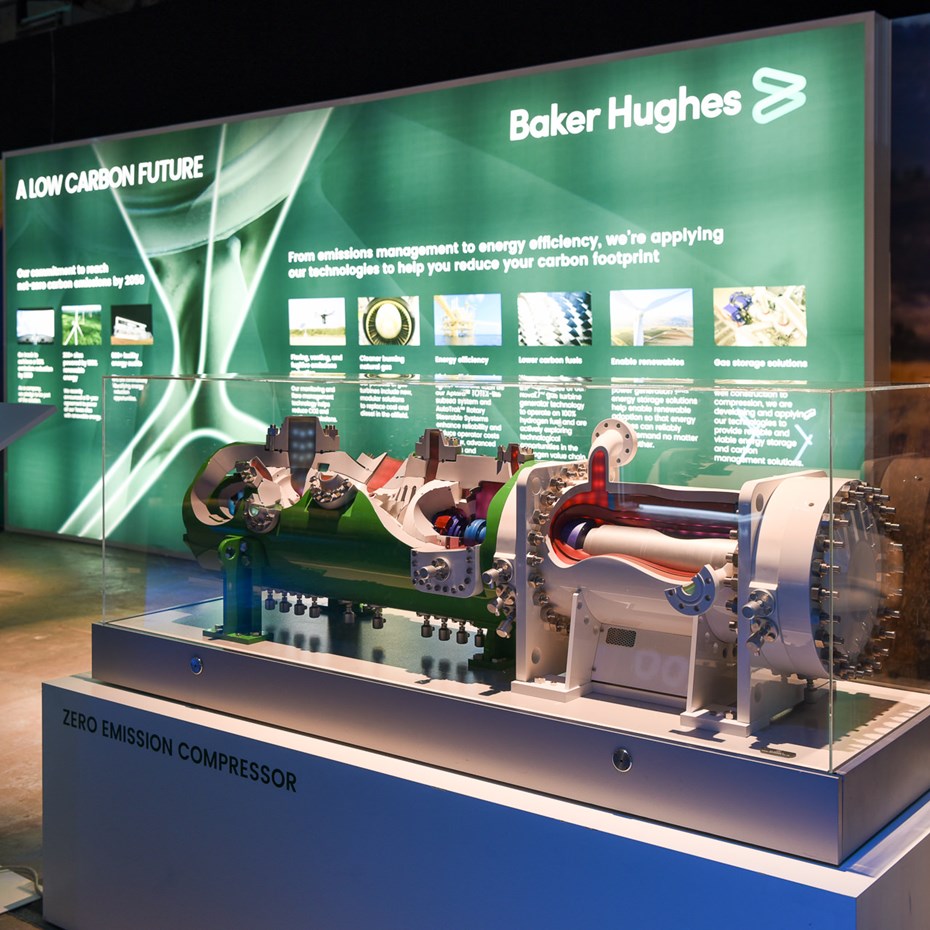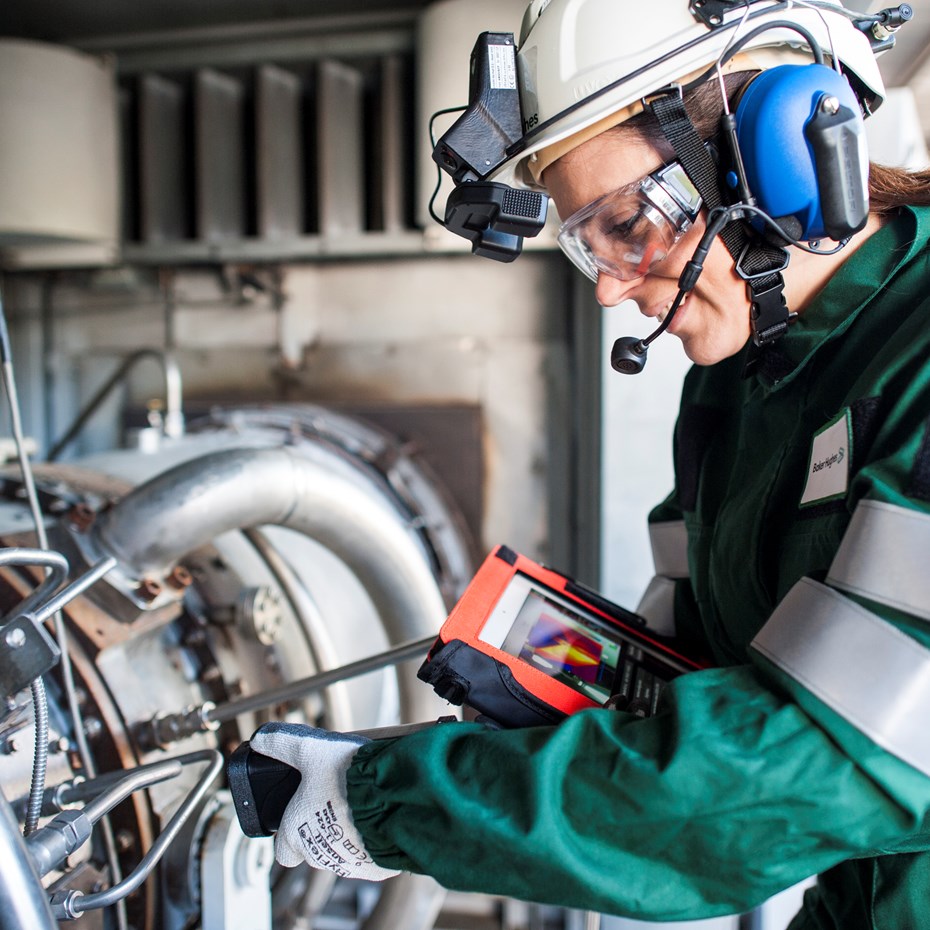Baker Hughes accelerating into the future of energy
How is Baker Hughes transforming itself to be ready for the future of energy?
As we continue to navigate the pandemic and macro-economic issues, I find it is best to focus on what we do know and what we can control. We know that the world needs more energy, and the world needs more from energy. We don’t see that outlook changing short term or long term. For that reason, our purpose at Baker Hughes is clear, and our commitment is firm. We make energy safer, cleaner and more efficient for people and the planet.
I am proud that our people push the boundaries of what’s possible, and we are transforming ourselves as an energy technology company to lead in the energy transition. We use technologies that explore the future of design and manufacturing, artificial intelligence and computing at the edge to evolve our portfolio to lead through the energy transition as a company and for our customers.
Baker Hughes has a clear strategy to navigate the energy transition, summarised in three strategic pillars:
1. Transform the core: Over the past two years, notably pre-COVID-19, we have been transforming our core product companies to improve our core competitiveness by focusing on future-proof technology and execution excellence.
2. Invest for growth: We will build a more diversified energy and industrial business to leverage our existing strengths, portfolio, and technology positions to provide solutions to serve growth sectors. These strengths include industrial asset management, AI and digital transformation, non-metallic solutions, additive manufacturing, and chemicals.
3. Position for new frontiers: As the energy landscape continues to change, we are evaluating the other growth areas associated with energy transition and where Baker Hughes can capitalise on opportunities through it’s existing capabilities. New energy frontiers include hydrogen, geothermal, CCUS, and energy storage, and we are strategically investing and collaborating in these areas to accelerate the energy transition.

Our strategy is not only focused on financial and operational excellence. It is also heavily focused on ESG leadership and Corporate Responsibility, including our net-zero emissions commitment. In early 2019, Baker Hughes was among the first in the industry to make a commitment to achieve net-zero carbon emissions from our operations by 2050 as well as use our own portfolio to help the industry control and reduce its emissions. Ultimately, this commitment plays an important part in driving our strategic decision-making and R&D approach. Maintaining focus allows us to manage across market cycles in pursuit of a low- to zero-carbon energy future.
What is your outlook for the energy industry in the future?
As we look ahead in 2021, we are cautiously optimistic that the global economy and oil demand will begin to recover from the impact of the global pandemic. Assuming a successful roll out of vaccines around the world, a synchronised global recovery should help drive solid growth in oil demand over the next 12 to 18 months and support a meaningful reduction in excess capacity over that time period. We expect spending and activity levels to gain momentum over the course of the year as the macro environment improves, likely setting up the industry for stronger growth in 2022.
In the natural gas and LNG markets, 2020 proved to be a more resilient year for demand primarily due to growth in China and accelerated coal-to-gas switching across several countries. We believe this resiliency highlights the structural demand growth for LNG and reaffirms our positive long-term view for natural gas as a transition and destination fuel for broader energy consumption.

Why do you think the energy industry is pivoting to a low- to zero-carbon energy future?
The energy transition is being driven by climate change and digital transformation – and 2020 accelerated our view of the future. The energy transition is both a challenge and an opportunity, and it will play an important role in the industry’s recovery.
Energy security must still be considered in the energy transition. We cannot sacrifice availability at a reasonable price. Nearly one billion people still do not have access to electricity, and if we look outside of Europe and the U.S., we see a dramatically different picture in energy demand and access to affordable, clean energy. Therefore, the low- to zero-carbon solutions we develop must contemplate cost, carbon and criticality.
What are the major hurdles facing the energy industry when it comes to energy transition?
We must recognise our ability to adapt, and our skill in solving the complex technical challenges with advanced technologies, innovative thinking and unparalleled capabilities. The energy industry can be a positive agent of change.
We see three undeniable truths for the energy transition to succeed. First, we must move faster in the energy industry to see progress. Second, hydrocarbons will continue to have a role in the future, so we must increase efficiency. Third, we must collaborate more and in new ways. Through these three lenses, we can view the energy transition as an opportunity, helping to transform our operations and lead in decarbonisation and the quest for net-zero.

How can technology help accelerate energy transition?
Technology is a major driver to any change in the energy industry, and the energy transition is no exception. Without technology, solutions will not exist to help decarbonise industries, and current technologies would not be made more efficient. It is important we look at both our current and future technologies as opportunities to support the energy transition, especially when it comes to efficiency. The IEA has estimated that more than 40 percent of the Paris Agreement emissions reduction targets can be achieved through efficiency gains across industries. The energy industry is a huge part of that target, and technology is the way we can achieve it.
Are you working on technologies that can help de-carbonise fossil fuel production?
As an energy technology company, Baker Hughes stands apart from other companies for our ability to offer truly differentiated technology at scale across a variety of energy sources—from oil and gas to alternative and renewable energy. These are real capabilities our customers require and look for to reduce the carbon intensity of their operations, particularly on major projects. We are already working with many customers on a project-by-project basis to bring low-carbon technologies into regular operations.
There are four specific technologies we view as critical to our strategy to lead in the energy transition. Hydrogen as a fuel is a significant opportunity – we recently signed an agreement with NOVATEK to help decarbonise their LNG operations by using hydrogen blends with natural gas in their liquefaction processes. We also announced our intention to invest in the FiveT Hydrogen Fund in April, alongside industry leaders Chart Industries and Plug Power. These new investments will allow hydrogen infrastructure projects to accelerate at speeds we haven’t seen before.

CCUS – we are continuing to invest in this area, supporting new technologies to capture carbon in various ways and applying it across industrial industries. We recently acquired a company called Compact Carbon Capture to commercialise modular technology in this space, and we plan to scale it in the coming years. We have also signed several agreements with partners to jointly develop and explore new CCUS methods, including the mixed salt process.
Methane monitoring and reduction – we have a system called LUMEN, using land and drone sensors to detect methane leaks in oil & gas operations, down to the inch.
Emissions control – Flare.IQ is a promising technology we introduced which can help operators manage their flare stack emissions using sensors and software in real time.
How is Baker Hughes pushing its digitalisation journey in the new energy landscape?
We strongly believe that digital transformation is needed to accelerate the energy transition, and we have taken several steps to advance our strategy. In 2019, Baker Hughes and C3 AI announced a joint venture agreement to accelerate the delivery of artificial intelligence (AI) technology to the oil and gas industry. BHC3 is a joint venture agreement to facilitate collaboration between Baker Hughes and C3.ai on the sale, development, and servicing of AI technologies for optimising oil and gas operations.
AI is critical for the energy transition, helping to reduce carbon emissions by managing energy use and reducing breakdowns that unnecessarily extend emissions-producing operations. The same technology can improve remote facilities, enabling remote monitoring and diagnostics as well as remote operations teams to analyse more data, use AI to identify patterns and anomalies, and automate processes to improve performance and uptime.
In addition, we are applying AI to our internal performance and processes. In fact, majority of our drilling operations are now conducted remotely – more than 80 percent at the end of 2020. The boundaries between the physical, digital, and biological worlds are becoming blurred. It's a fusion of advances in artificial intelligence, robotics, the Internet of Things (IoT), 3D printing, genetic engineering, quantum computing, and other technologies, known as the Fourth Industrial Revolution (4IR).
The survival of companies will depend on their ability to develop new capabilities, different business models and a mindset centered around agility and collaboration to keep up with the trends of the 4IR. We will also see an increase in remote operations, including remote facilities and remote monitoring and diagnostics. AI will enable remote operations teams to analyse more data by using AI to identify patterns and anomalies, and automate processes to improve performance and uptime.
How are you continuing to invest in innovation across both the oil and gas and energy value chains?
Our culture is built on a heritage of innovation and invention in research and development, with complementary capabilities. Technology remains a differentiator for Baker Hughes, and our technology innovation helps to drive the efficiency and productivity gains our customers need. We also have a range of technologies that support our customers' efforts to reduce their carbon footprint, with innovation a heavy focus over the next few years as we continue to position ourselves for new energy frontiers. We remain committed to investing in our products and services to maintain our leadership position across our offerings, including a $595 million research & development spend in 2020.
How can energy efficiency help companies meet sustainability targets and what are you doing in this space?
It is important we look at both our current and future technologies as opportunities to support the energy transition, especially when it comes to efficiency. There is no scenario in our future where hydrocarbons disappear, so improving efficiency is essential.
As I mentioned earlier, IEA has estimated that 37 percent of the Paris Agreement emissions reduction targets can be achieved through efficiency gains across industries. The energy industry is a huge part of that target, and technology is the way we can achieve it. Energy technology plays a critical role to make meaningful efficiency improvements, and we continue to scale faster to see progress.
Natural gas can and should serve as a transition and destination fuel – its environmental benefits are clear, and its efficiency is compelling. LNG is a favourable option for many countries. We are improving LNG’s total emissions profile to ensure it supports the energy transition.
Also, digital asset management keeps operations cleaner and more efficient, capturing fugitive emissions. Our customers like Petrobras are deploying the latest generation of Bently Nevada solutions and Flare IQ monitoring systems, which can help monitor and reduce emissions like methane. Methane has historically been overlooked by the energy sector, but venting, fugitives and flaring are the single biggest opportunity to reduce greenhouse gas emissions, even more than carbon dioxide.

What do you see as the future of the next generation of energy workers?
We need innovators to help us lead in the energy transition. We also know that the future is even more digital than it is today, and we know that traditional oil and gas jobs are not going to return to the same levels they once were. The next generation of leaders for our industry must have a digital-first mindset and be willing to innovate to find new ways to reach a net-zero future. The energy industry has a huge opportunity to make a positive change for the world’s climate goals. The industry’s reputation as slow-moving can be changed with new perspectives, so we need a new generation of the workforce to help take energy forward.
We must continue our focus on diversity, equity and inclusion, which is a core part of our Corporate Responsibility and ESG strategy. Diversity will remain a top priority for our recruitment efforts, and we know that diverse teams are more productive and achieve greater results.
At dmg events we are launching our new energy platform, Energy Connects. How important do you think it is to connect the whole energy value chain in one place?
It is extremely important we convene and collaborate as an energy industry, rather than in siloes as oil and gas, power generation, transmission, distribution, and others. To achieve a net-zero future, we all must work together and discuss our challenges and opportunities openly, and we can learn from each other.
Lorenzo will be speaking at the ADIPEC 2021 Strategic Conference at 2:30pm in the ICC Hall, ADNEC, Abu Dhabi on 15 November. The session will focus on the new normal for energy demand and how the company is transforming itself to be ready for the future of energy.
View the complete Strategic Conference programme: https://www.adipec.com/conferences/strategic-conference/
KEEPING THE ENERGY INDUSTRY CONNECTED
Subscribe to our newsletter and get the best of Energy Connects directly to your inbox each week.
By subscribing, you agree to the processing of your personal data by dmg events as described in the Privacy Policy.
















